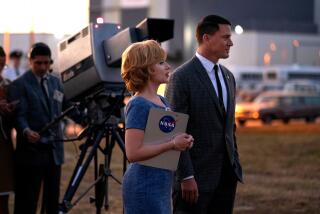Cannes 2011: ‘A Trip to the Moon’s’ long journey
- Share via
Reporting from Cannes, France — — Not every hot film in Cannes is brand spanking new. This year one of the most talked-about movies is also one of the oldest ever made. That would be a newly restored, vivid color edition of Georges Melies’ 1902 short “A Trip to the Moon,” a version that was thought lost forever after it had disappeared from sight decades ago.
“It’s one of the most famous films in the world. The shot of the man in the moon with a rocket in his eye is one of the 10 images everyone knows, except no one has seen it like this,” said Serge Bromberg of France’s Lobster Films, the driving force behind the restoration, a project some 20 years in the making.
By all accounts, the 14-minute “Trip to The Moon” was the most popular film of its day. “For 10 years, everyone wants to see it,” Bromberg said. “Plus all the other film distributors — Selig, Edison, Lubin — all made copies of it and sold it as their own. Melies was the first film piracy victim. He didn’t get the credit or the money.”
Because hand-tinting color prints was a process Melies, a former magician credited with being one of the founding fathers of cinema, offered to only his wealthiest clients, few color prints of any of his films survive. Yet, in 1993, a Spanish collector deposited the sole color copy of “Trip to the Moon” in a Barcelona archive. Bromberg made an exchange with the archive and acquired the print, but it was in such poor condition that it took years to even begin to determine how to resurrect the 13,375 frames.
“The film was almost totally decomposed, completely stuck together, like a souvenir of the Holy Grail,” Bromberg said. “You can’t raise the dead, there is no such thing as Dr. Frankenstein in real life. To put it another way, you can’t turn hamburger back into a cow.”
“When we started,” he said, “to salvage even 20 frames was already science fiction.”
What Bromberg and his associates eventually came up with was the notion of putting the film in “a glass bowl with some kind of chemical vapor that leads to complete destruction. But there would be one step during that ultimate decomposition when the film would become soft and if we are there for those few hours it would be possible to photograph it frame by frame.
“So every day for two years we opened the print to see if we can slice off a little bit to photograph, maybe a frame, maybe a quarter of a frame,” Bromberg continued. “Finally we have 90 to 95% of the original color print stored first on floppy discs and then on a hard drive for backup.”
But what to do with all those images? “The technology,” Bromberg said, “was not there for eight years.” By 2010, the art of digital restoration had advanced to the point where Bromberg was able to enlist the aid of two French foundations — Fondation Groupama Gan Pour Le Cinéma and Fondation Technicolor Pour Le Patrimoine Du Cinéma — to come up with the more than $500,000 needed to do the job.
The actual restoration was done in Los Angeles, at Technicolor’s laboratories under the supervision of Tom Burton. The foundations also selected the French group Air to compose a new soundtrack for the film.
The magical colors of “Trip to The Moon” astounded audiences when the restored version was shown in Cannes earlier this week. “The difference between black and white and color in this case,” said Bromberg, “is the difference between having a marijuana cigarette unlit and one that you are smoking.”
After its world premiere at Cannes, Bromberg hopes to screen the restoration at the Telluride Film Festival and at the Academy of Motion Pictures Arts and Sciences in Los Angeles.
“The colors are strong, vulgar and magnificent at the same time,” Bromberg said. “They’re a mixture of art and the fairgrounds that brings us back to the innocence of the cinema. It’s the dream of 1902 mixing with the technology of 2010 to restore an original fantasy.”
More to Read
The biggest entertainment stories
Get our big stories about Hollywood, film, television, music, arts, culture and more right in your inbox as soon as they publish.
You may occasionally receive promotional content from the Los Angeles Times.











